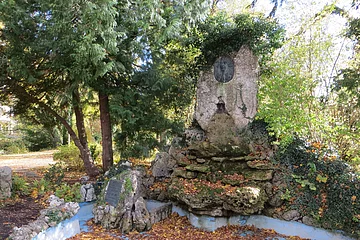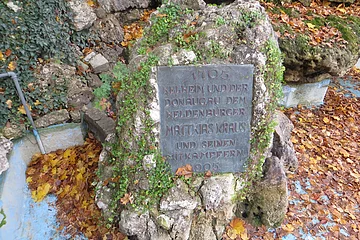When leaving Kelheim’s historic city centre through the “Danube Gate” (Donautor) and walking towards the embarkation point for the ships to Weltenburg, you may easily overlook a historic spot to your left. Hidden by trees and bushes there is an old fountain, made to resemble a cliff, with a metal plate showing the portrait of Matthias Kraus, a butcher from Kelheim. What makes him so special? you might ask. To answer that question, we have to go back to the 17th century.
Matthias Kraus was born on the 18th of February 1671. Due to the War of the Spanish Succession which lasted thirteen years, there were many conflicts and changes of power in Europe at this time. Kelheim at some point was defeated and placed under Austrian occupation. Because of the oppression, scavenging and forced recruitments by the soldiers of the emperor, the population was discontent and eventually, in November of 1705, a rebellion arose. It was led by none other than Matthias Kraus. Amazingly, the rebels achieved a brief victory over the Austrians and were able to temporarily liberate the city. During this period, Matthias Kraus declared himself commander of the city. However, because of the lack of support from the city council, Kraus could not defend the city against the Austrians for long and had to flee to Braunau. He returned in December of the same year but was betrayed by the Austrian town clerk. Given the military superiority of the Austrian troops, the people of Kelheim decided to lay down their arms against Kraus’ will, once again letting him down. The spokesmen for the town asked for favourable conditions in exchange for their surrender and the Austrians accepted, later, however, they broke the agreement and treacherously killed nearly two hundred citizens. The next day, Kraus was found hiding in a beer barrel and promptly decapitated on the 17th of March 1706. In order to make his punishment appear even more spectacular, the Austrians quartered his corpse and hung the segments from the city gates as a deterrent to any future revolutionists. What’s more, they made leaflets saying that everybody who was disloyal to the Austrian country or its emperor, would suffer the same fate as Kraus.
Eventually in 1905, for the 200th anniversary of the armed uprising, the fountain that can still be seen today was built as a monument and memorial dedicated to Matthias Kraus and his fellow fighters. This is, however, not the only monument as there is also a painting on the “Middle Gate” (Mittertor) showing Kraus during his brief victory.


